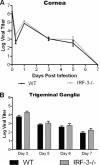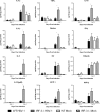Interferon regulatory factor 3-dependent pathways are critical for control of herpes simplex virus type 1 central nervous system infection
- PMID: 20660188
- PMCID: PMC2937762
- DOI: 10.1128/JVI.00706-10
Interferon regulatory factor 3-dependent pathways are critical for control of herpes simplex virus type 1 central nervous system infection
Abstract
The initiation of the immune response at the cellular level relies on specific recognition molecules to rapidly signal viral infection via interferon (IFN) regulatory factor 3 (IRF-3)-dependent pathways. The absence of IRF-3 would be expected to render such pathways inoperative and thereby significantly affect viral infection. Unexpectedly, a previous study found no significant change in herpes simplex virus (HSV) pathogenesis in IRF-3(-/-) mice following intravenous HSV type 1 (HSV-1) challenge (K. Honda, H. Yanai, H. Negishi, M. Asagiri, M. Sato, T. Mizutani, N. Shimada, Y. Ohba, A. Takaoka, N. Yoshida, and T. Taniguchi, Nature 434:772-777, 2005). In contrast, the present study demonstrated that IRF-3(-/-) mice are significantly more susceptible to HSV infection via the corneal and intracranial routes. Following corneal infection with 2 x 10(6) PFU of HSV-1 strain McKrae, 50% of wild-type mice survived, compared to 10% of IRF-3-deficient mice. Significantly increased viral replication and inflammatory cytokine production were observed in brain tissues of IRF-3(-/-) mice compared to control mice, with a concomitant deficit in production of both IFN-beta and IFN-alpha. These data demonstrate a critical role for IRF-3 in control of central nervous system infection following HSV-1 challenge. Furthermore, this work underscores the necessity to evaluate multiple routes of infection and animal models in order to fully determine the role of host resistance factors in pathogenesis.
Figures







Similar articles
-
Immune- and Nonimmune-Compartment-Specific Interferon Responses Are Critical Determinants of Herpes Simplex Virus-Induced Generalized Infections and Acute Liver Failure.J Virol. 2016 Nov 14;90(23):10789-10799. doi: 10.1128/JVI.01473-16. Print 2016 Dec 1. J Virol. 2016. PMID: 27681121 Free PMC article.
-
Control of herpes simplex virus replication is mediated through an interferon regulatory factor 3-dependent pathway.J Virol. 2009 Dec;83(23):12399-406. doi: 10.1128/JVI.00888-09. Epub 2009 Sep 16. J Virol. 2009. PMID: 19759149 Free PMC article.
-
Synergistic control of herpes simplex virus pathogenesis by IRF-3, and IRF-7 revealed through non-invasive bioluminescence imaging.Virology. 2013 Sep;444(1-2):71-9. doi: 10.1016/j.virol.2013.05.034. Epub 2013 Jun 16. Virology. 2013. PMID: 23777662 Free PMC article.
-
Pathogenesis of Herpes Stromal Keratitis: Immune Inflammatory Response Mediated by Inflammatory Regulators.Front Immunol. 2020 May 13;11:766. doi: 10.3389/fimmu.2020.00766. eCollection 2020. Front Immunol. 2020. PMID: 32477330 Free PMC article. Review.
-
The role of chemokines during herpes simplex virus-1 infection.Front Biosci. 2008 May 1;13:4862-72. doi: 10.2741/3045. Front Biosci. 2008. PMID: 18508551 Free PMC article. Review.
Cited by
-
A neuron-specific role for autophagy in antiviral defense against herpes simplex virus.Cell Host Microbe. 2012 Sep 13;12(3):334-45. doi: 10.1016/j.chom.2012.07.013. Cell Host Microbe. 2012. PMID: 22980330 Free PMC article.
-
Immune- and Nonimmune-Compartment-Specific Interferon Responses Are Critical Determinants of Herpes Simplex Virus-Induced Generalized Infections and Acute Liver Failure.J Virol. 2016 Nov 14;90(23):10789-10799. doi: 10.1128/JVI.01473-16. Print 2016 Dec 1. J Virol. 2016. PMID: 27681121 Free PMC article.
-
Nuclear IFI16 induction of IRF-3 signaling during herpesviral infection and degradation of IFI16 by the viral ICP0 protein.Proc Natl Acad Sci U S A. 2012 Oct 30;109(44):E3008-17. doi: 10.1073/pnas.1211302109. Epub 2012 Oct 1. Proc Natl Acad Sci U S A. 2012. PMID: 23027953 Free PMC article.
-
Anti-viral and anti-inflammatory mechanisms of the innate immune transcription factor interferon regulatory factor 3: relevance to human CNS diseases.J Neuroimmune Pharmacol. 2013 Mar;8(1):132-44. doi: 10.1007/s11481-012-9360-5. Epub 2012 Jun 10. J Neuroimmune Pharmacol. 2013. PMID: 22684309 Review.
-
Innate immune interactions within the central nervous system modulate pathogenesis of viral infections.Curr Opin Immunol. 2015 Oct;36:47-53. doi: 10.1016/j.coi.2015.06.011. Epub 2015 Jul 8. Curr Opin Immunol. 2015. PMID: 26163762 Free PMC article. Review.
References
-
- Aravalli, R. N., S. Hu, T. N. Rowen, J. M. Palmquist, and J. R. Lokensgard. 2005. TLR2-mediated proinflammatory cytokine and chemokine production by microglial cells in response to herpes simplex virus. J. Immunol. 175:4189-4193. - PubMed
-
- Asselin-Paturel, C., A. Boonstra, M. Dalod, I. Durand, N. Yessaad, C. Dezutter-Dambuyant, A. Vicari, A. O'Garra, C. Biron, F. Briere, and G. Trinchieri. 2001. Mouse type I IFN-producing cells are immature APCs with plasmacytoid morphology. Nat. Immunol. 2:1144-1150. - PubMed
-
- Bjorck, P. 2001. Isolation and characterization of plasmacytoid dendritic cells from Flt3 ligand and granulocyte-macrophage colony-stimulating factor-treated mice. Blood 98:3520-3526. - PubMed
Publication types
MeSH terms
Substances
Grants and funding
LinkOut - more resources
Full Text Sources
Medical
Molecular Biology Databases

